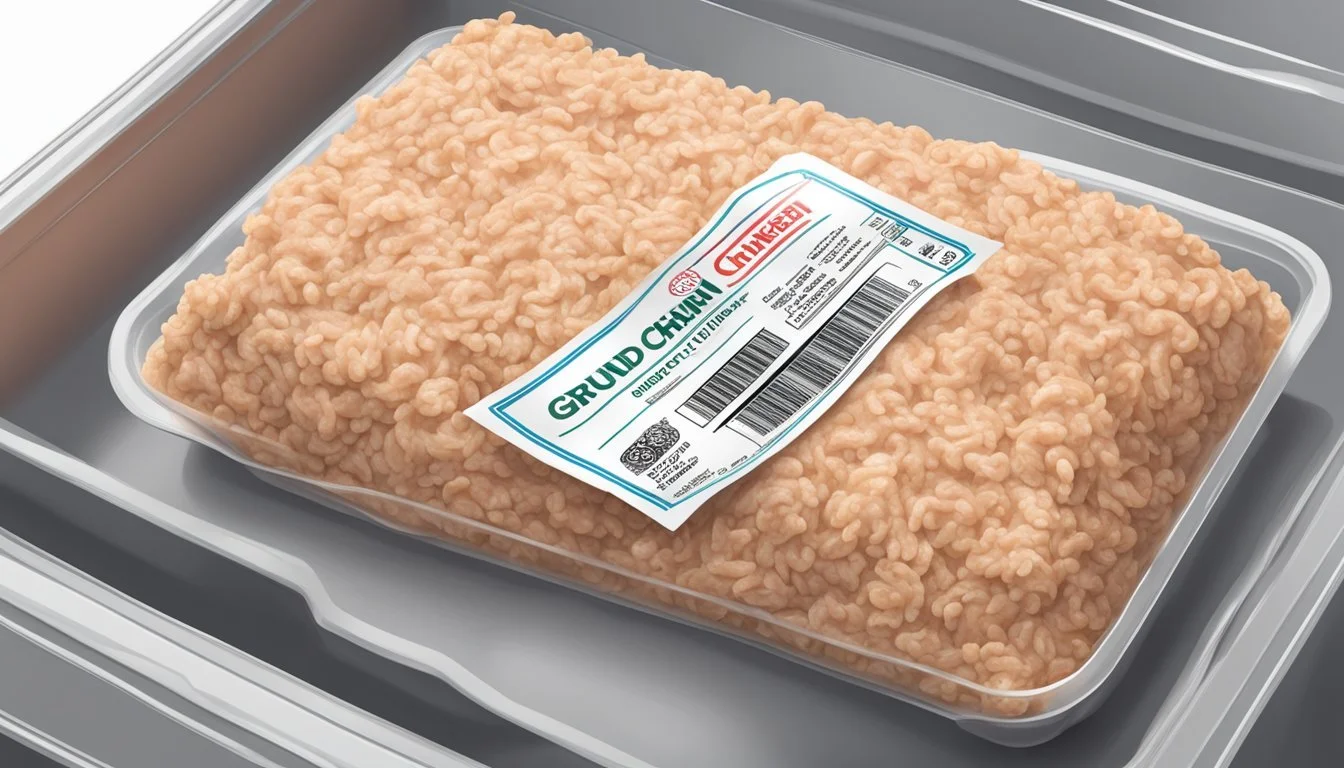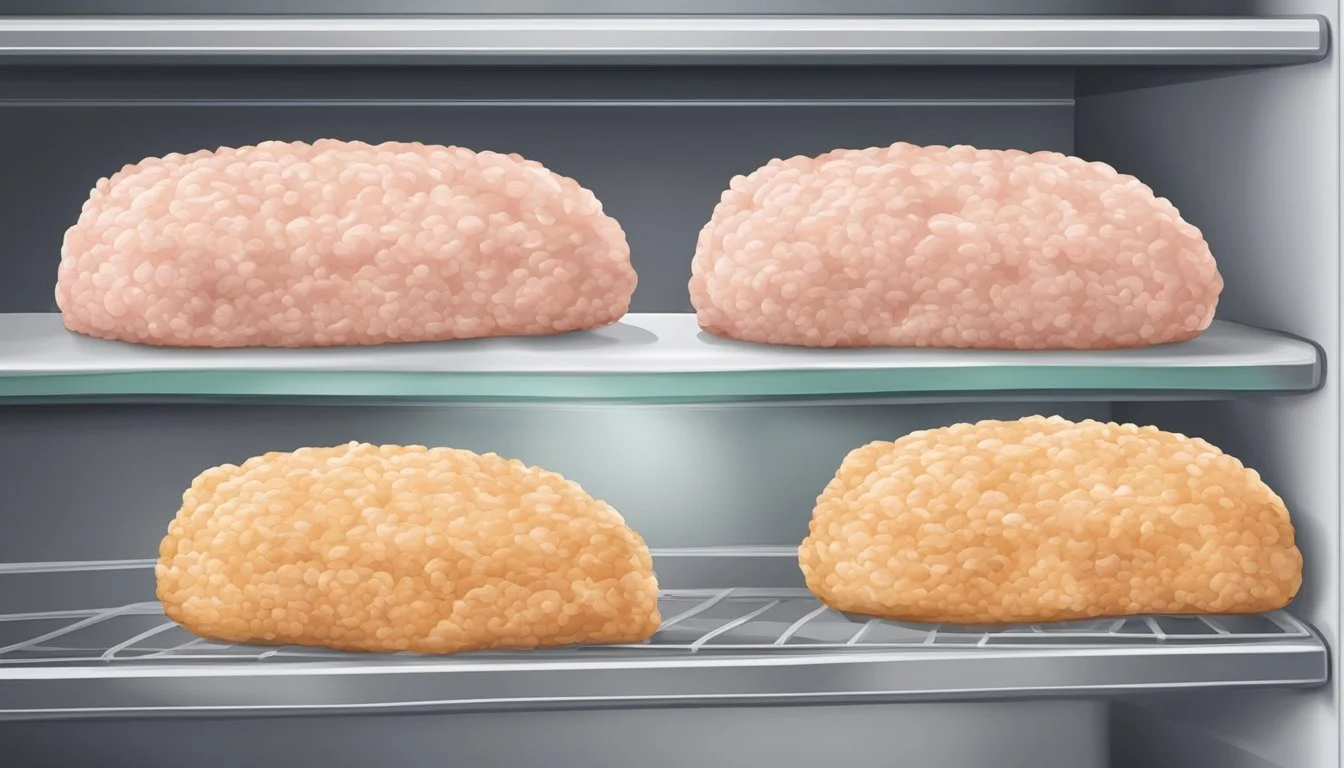How Long Does Ground Chicken Last?
Shelf Life and Storage Tips
Ground chicken (how long does chicken last?), like many perishable proteins, has a limited shelf life which can raise questions about storage and safety. In the refrigerator, raw ground chicken should be consumed within one to two days. This brief window is to ensure both safety and quality, as ground meat is more susceptible to bacterial growth than whole cuts due to increased surface area.
When frozen, ground chicken preserves its quality for about three to four months. While it remains safe to eat beyond this period if kept at a consistent 0°F, the texture and flavor may degrade. To maintain its condition, ground chicken should be stored in an airtight container or tightly sealed freezer bag. Proper storage methods are crucial to extending the shelf life and preventing freezer burn.
Consumers often rely on these guidelines to prevent foodborne illness and minimize waste. It is vital to note that once cooked, ground chicken can be refrigerated for three to four days. Regardless of storage, observing proper hygiene and handling procedures during preparation can significantly reduce the risk of contamination.
Understanding Ground Chicken
Ground chicken is versatile and can be used in various recipes. It is valued for its protein content and leaner profile compared to other meats.
Definition and Benefits
Ground chicken refers to the product made by grinding chicken meat, often including both dark and white cuts. Recognized for its high protein content, ground chicken serves as a leaner alternative to ground beef or pork in many dishes. Its reduced fat content makes it a healthier choice for those looking to maintain a balanced diet. Due to its fine texture, it readily absorbs flavors from spices and other ingredients, making it an ideal component in a wide array of cuisines.
Protein-rich: An excellent source of protein, essential for muscle repair and growth.
Less fat: Generally contains less fat than other ground meats, supporting a healthier lifestyle.
Versatility in cooking: Can be easily seasoned and incorporated into numerous recipes.
Ground Chicken as an Ingredient
In the realm of cooking, ground chicken is highly versatile and adapts to multiple recipes such as meatballs, lasagna, and various ethnic dishes. Its subtle flavor provides a backdrop that allows the spices and accompanying ingredients to shine. Additionally, as an ingredient, ground chicken often requires a shorter cooking time compared to other ground meats, offering convenience in meal preparation.
Key ingredient for many dishes:
Meatballs
Lasagna
Burgers
Stir-fry dishes
Cooking applications: Can be baked, sautéed, grilled, or used in slow cooker recipes.
Suitable for all meals: Fits into breakfast, lunch, and dinner options, underscoring its status as a staple in poultry-based cooking.
Using ground chicken in recipes can enhance the nutritional value of a meal while providing a satisfying and enjoyable dining experience.
Fresh Ground Chicken Storage
When storing fresh ground chicken, the key factors to consider are temperature control and minimizing exposure to air. By storing ground chicken properly in the refrigerator or freezer, one can extend its shelf life while maintaining its safety and quality.
Refrigerator Storage
Fresh ground chicken should be stored in the refrigerator as soon as it is brought home from the store. It's a highly perishable food that needs to be refrigerated at temperatures below 40°F to slow down bacterial growth.
Duration: Store fresh ground chicken in the fridge for 1 to 2 days.
Packaging: Keep it in its original packaging or place it in an airtight container to prevent cross-contamination.
Precaution: Always place it on the lowest shelf to prevent any dripping onto other foods.
Freezer Storage Tips
For longer storage, one should freeze ground chicken:
Duration: It maintains its best quality for about 3 to 4 months in the freezer.
Containers: Use freezer-safe containers, reliable freezer bags, or wrap it securely in aluminum foil or plastic wrap, followed by a layer of foil.
Freezer Burn: Minimize freezer burn by ensuring containers are airtight and removing as much air as possible.
Labeling: Always label the packaging with the date of freezing to keep track of how long it has been stored.
Temperature: Maintain a consistent freezer temperature at or below 0°F.
By adhering to these specific storage methods, one ensures the shelf life of fresh ground chicken is maximized without compromising its safety or quality.
Indicators of Spoilage
When assessing ground chicken for spoilage, one should pay close attention to visual changes and variations in odor and texture. These indicators are telltale signs of whether the ground chicken is still suitable for consumption or if it needs to be discarded to prevent the risks associated with foodborne illnesses.
Visual Cues
The color of fresh ground chicken typically ranges from pale pink to light white. Upon spoilage, there might be a noticeable shift to a dull color, such as grey or brown. These color changes suggest microbial growth and the start of spoilage. Additionally, any spots or areas of discoloration that stray from the natural fresh coloration should be taken as a warning sign.
Odor and Texture
Ground chicken that emits a sour smell or bad odor commonly indicates spoilage. This type of smell can be described as sulfur-like or simply off-putting. In terms of texture, fresh ground chicken should be moist but not slimy. A slimy texture upon touch is a critical sign that the ground chicken has spoiled. Lastly, a sticky feel is another red flag, further confirming that the meat is not safe for consumption. When any of these characteristics are identified, it's crucial to discard the ground chicken immediately to avoid health hazards.
Safety and Health Considerations
Ensuring the safety and quality of ground chicken is critical to prevent foodborne illnesses and maintain health standards. The focus herein is on the prevention of harmful bacteria growth and the proper handling and cooking techniques to mitigate health risks associated with raw poultry.
Preventing Foodborne Illness
To safeguard against bacteria such as Salmonella and Campylobacter, which can lead to serious foodborne illness, it is imperative to manage ground chicken with utmost care. These steps are essential:
Storage: Keep raw ground chicken refrigerated at 40°F (4°C) or below and use within 1-2 days. For longer storage, freeze at 0°F (-18°C) for up to 3-4 months.
Thawing: Thaw frozen ground chicken in the refrigerator or using a microwave, not at room temperature.
Cross-contamination: Use separate utensils and cutting boards for raw chicken and other foods. Wash hands, surfaces, and utensils with hot, soapy water after contact with raw meat.
Food Safety: Always cook ground chicken to an internal temperature of 165°F (74°C), as measured with a food thermometer, to eliminate harmful bacteria.
Proper Handling and Cooking
Proper handling and cooking are essential to keep ground chicken safe to eat:
Handling: Handle raw ground chicken with clean hands and use clean kitchen tools to avoid contamination.
Cooking: Cook ground chicken thoroughly, whether frying, baking, or grilling, ensuring that it reaches the safe minimum internal temperature.
Throughout this process, precaution is key. If the ground chicken displays signs of spoilage such as an off-odor, discoloration, or a slimy texture, it should not be consumed, as these are indicative of bad chicken that could cause illness. By adhering to food safety guidelines, the risk of foodborne illnesses caused by improper handling and storage of ground chicken is significantly reduced.
Maximizing Shelf Life
Preserving the freshness of ground chicken involves implementing proper freezing and thawing techniques, along with maintaining optimal storage conditions to extend its usability.
Freezing and Thawing Techniques
To effectively freeze ground chicken, one should:
Store it in a freezer-safe container or wrap it tightly in heavy-duty aluminum foil or plastic wrap.
Label the package with the freezing date to keep track of the storage time.
Maintain a consistent freezer temperature of 0°F or below to prevent bacteria growth.
For safe thawing:
Refrigerate the ground chicken overnight, allowing it to thaw gradually.
Submerge the ground chicken in cold water, changing the water every 30 minutes.
Use a microwave for faster thawing, with the intention to cook the chicken immediately after, as some areas may start to cook during the microwave thaw process.
One should never refreeze raw ground chicken that has been thawed.
Extending Freshness and Usability
Proper refrigerator storage extends the ground chicken's freshness:
Consume or freeze ground chicken within 1 to 2 days of purchase.
Keep the refrigerator at a temperature below 40°F to slow down bacteria growth.
Expiration dates on packaging should guide usage; however, if no date is provided, the 1 to 2-day rule is a standard practice.
After cooking, one can refrigerate cooked ground chicken for 3 to 4 days and freeze it for up to 4 months for best quality.
By adhering to these techniques, they can maximize the shelf life and safety of their ground chicken.
Recommendations for Use
When cooking with ground chicken, one must consider the freshness of the meat to ensure both safety and flavor. Optimal storage times significantly influence the end result of the prepared dish, be it meatballs, lasagna, or any other ground chicken-based recipe.
Cooking Techniques
Ground chicken, due to its lean texture, requires careful cooking to retain moisture and develop flavor. For meatballs, combining ground chicken with breadcrumbs and a binding agent such as eggs can maintain tenderness. When cooking, meatballs should be browned on all sides to create a flavorful crust before finishing in the oven or sauce.
For lasagna, layering the ground chicken with cheese and sauce aids in keeping the meat succulent as it cooks within the casserole. Moreover, ground chicken should always reach an internal temperature of 165°F to ensure safety and prevent food-borne illness.
Creative Recipes and Alternatives
Ground chicken serves as a versatile ingredient, suitable for numerous dishes and alternative recipes. In place of beef or pork, ground chicken can lighten up traditional recipes such as:
Tacos: Substitute ground beef with seasoned ground chicken for a healthier touch.
Burgers: Mix ground chicken with spices, and form into patties for a lighter alternative to beef burgers.
One can also explore alternative ingredients to enhance ground chicken. For instance:
Quinoa or oats can extend the meat in recipes while adding a nutritious boost.
Vegetables like grated zucchini or carrot can add moisture and flavor to dishes.
Experimenting with recipes using ground chicken can introduce new textures and flavors to one's cooking repertoire, all while maintaining the essence of classic dishes.





